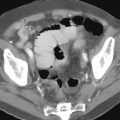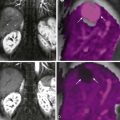Chapter Outline
Clinical Indications and Comparison With Other Imaging Methods
Technical Pitfalls and Limitations
“As the number of imaging examinations and radiologic procedures continues to rise, so do radiologists’ opportunities to improve their roles as consultants and clinical team members.” The mesenteric small intestine is the most challenging segment of the gastrointestinal (GI) tract to examine. It is the longest segment of the alimentary tube and has the widest mucosal surface, yet the incidence of disease is low and the clinical presentations are mimicked by diseases of adjacent visceral organs, with a higher incidence of abnormalities. The significant role of imaging, therefore, is to exclude small bowel (SB) disease reliably or diagnose early, small, or localized disease with confidence.
Methods of imaging that do not distend the SB lumen have historically been shown not to allow reliable exclusion of SB disease or early demonstration of small or early mucosal or submucosal abnormalities. In addition, these examinations do not give the radiologist and clinician the confidence to exclude small neoplasms and low-grade SB occlusion (SBO) or depict early mucosal SB Crohn’s disease (aphthae) or nonsteroidal anti-inflammatory drug (NSAID) enteropathy. SB imaging reports are therefore not infrequently equivocal or noninformative, and repeated imaging examinations or performance of more expensive and invasive endoscopic methods are done before a definitive diagnosis or confident exclusion of SB disease is made.
The investigation of SB diseases requires methods of examination that have a high negative predictive value and high sensitivity. Intubation infusion examinations (enteroclysis and its modifications) have been shown to overcome most of the inherent limitations of conventional examinations (peroral ingested or nonenteral volume-challenged) but have inherent limitations. Decades of experience have shown that only examinations that distend the lumen and coat the mucosa fulfill these roles. Several of these reports were not generated from well-controlled clinical trials; many are experience-based. The enteroclysis technique and its modifications have remained the most accurate methods that reliably exclude SB abnormalities and allow early diagnosis of disease.
Progress in imaging of the SB during the past few decades has largely occurred because of refinements in the application of various modalities. These include orally ingested conventional abdominal and pelvic computed tomography (CT) or magnetic resonance imaging (MRI) with intravenous (IV) contrast (CT enterography and MR enterography), conventional barium enteroclysis methods (computed tomography enteroclysis [CTE] and magnetic resonance enteroclysis [MRE]), and technical refinements in performing double-contrast (DC) barium enteroclysis.
Some updates on how to perform CTE, its modifications, and DC barium enteroclysis, as well as its clinical applications, have been recently described but are beyond the scope of this chapter. Interested readers are referred to these articles.
This chapter presents an update of the current role of CTE modifications in the diagnosis and management of SB diseases from evidence- and experience-based analyses. We examine why enteral volume-challenged examinations, despite their reported higher accuracy and reliability in ruling out SB disease, are infrequently performed in clinical practice. The roles of the different modifications of CTE are discussed. Evidence- and experience-based recommendations are made to improve early diagnosis and influence prognosis, decrease irradiation of the patient, and lower the costs of investigation. An overview of clinical indications, comparison with other cross-sectional imaging techniques, common technical pitfalls, and limitations are briefly presented.
Historical Background
Enteroclysis was first described by Pesquera in 1929. Several investigators have modified his technique, but the method did not gain popularity because of technical problems, including issues with enteric tubes and inadequacy of fluoroscopic units. It was not until 1971 that Johan Sellink rejuvenated the technique in Europe and received attention in North America through additional publications by several investigators in the late 1970s and early 1980s. His technique was tried by interested radiologists in North America but was not adopted by most of them because of discomfort to patients and the time requirement. Klöppel modified the Sellink method using a lower density, water-soluble enteral contrast and adapted it to monoslice CT. With the development of multislice CT technology, this method was subsequently modified by Maglinte and colleagues into a positive enteral contrast CTE and a neutral enteral contrast with IV contrast CTE in several newer studies.
Each modification has distinct strengths and limitations for different clinical indications. An 11% dilution of water-soluble contrast was used for the positive enteral contrast CTE after trials of multiple dilutions of iodinated contrast, and water was used for the neutral enteral contrast with IV contrast CTE. Using a wide window CT setting for the positive enteral contrast optimizes visualization of the valvulae conniventes from several dilutions that we have tried in the past. The use of methylcellulose suspension, which has been withdrawn from commercial distribution in the United States because of contamination as a neutral enteral contrast, was abandoned and replaced with plain tap water for the neutral CTE with IV contrast modification. Absorption is not an issue with CTE compared with CT enterography because of the volume used, the use of a hypotonic agent (glucagon), and continued infusion during CT acquisition ( Fig. 39-1 ). Biscaldi and associates have applied the enteroclysis technique using retrograde infusion for selected indications.
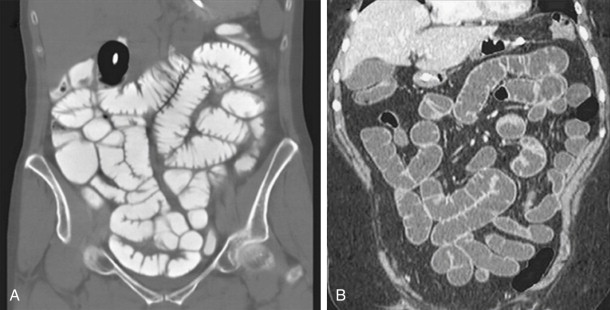
Enteroclysis and its cross-sectional modifications, despite their reported accuracy, are mostly performed as a problem-solving tool in tertiary medical centers at present. This method usually follows an orally ingested SB examination (conventional abdominal-pelvic CT with oral and IV contrast, CT enterography, or MR enterography) in patients with negtive or equivocal findings or with persistent symptoms despite negative findings. In a minority of specialist centers, in which the various enteroclysis modifications are done regularly, the method is used as a primary diagnostic investigation to exclude or diagnose early SB disease confidently. It is also used in patients with high clinical suspicion of SB disease to decrease radiation burden, decrease cost of work-up, and minimize delays in the diagnosis of SB diseases.
Clinical Indications and Comparison with Other Imaging Methods
The lack of a current evidence-based guideline results in inappropriate use and overuse in clinical practice, wasting expenditures by inappropriate referrals, incorrect interpretation, and duplicative use and resulting in increased cost of investigation, increased radiation burden to patient, and delays in diagnosis, which influence prognosis. Evidence- and experience-based comparisons provide insights on the clinical performance of the different methods of investigation of SB diseases and a rational basis for making recommendations. Although there are limitations in the appraisal of these research studies, they can provide useful guidelines for optimal use of current imaging studies.
Small Bowel Crohn’s Disease
In the United States, CT enterography has recently replaced small bowel follow-through (SBFT) as the most frequently used method of SB imaging, particularly for SB Crohn’s disease in most practices. With advances in multidetector CT technology, there is validity in this shift. Multidetector CT has simplified evaluation of the small intestine and mesentery compared with the SBFT. The term CT enterography was first introduced by Zamboni and Raptopoulos in 1997 in reference to a modified abdominal CT technique to address SB Crohn’s disease. A large volume of a 2% barium-based or 2% to 5% water-soluble, iodine-based, oral contrast material was administered 1 to 2 hours before scanning. A high dose of IV contrast material and biphasic injection rate regimen of IV contrast were used.
Another orally ingested SB-focused CT method was subsequently described, in which a neutral enteric contrast material (polyethylene glycol [PEG] solution and whole milk) and isotonic oral solution were used. It was not until 2006, when the Mayo Clinic Rochester group reported their experience initially using water and a water-methylcellulose solution, which was replaced by a PEG electrolyte solution and subsequently by low-concentration barium (0.1% w/v ultra–low-dose barium with sorbitol [VoLumen, Bracco Diagnostics, Princeton, NJ]), that CT enterography caught the attention of the radiology and gastroenterology community. Invited commentaries, which accompanied the reports by Bodily, Paulsen, and Maglinte and their colleagues predicted that CT enterography would replace the traditional SBFT as the initial radiologic method of investigation for SB Crohn’s and other SB diseases if expertise in DC barium enteroclysis or CTE were not available. Enteroclysis is used as a problem-solving tool in referral centers when questions relevant to management are not fully answered by CT enterography.
The optimal radiologic approach to the patient with suspected, early SB Crohn’s disease, or when the clinical indication is to rule out SB Crohn’s disease compared with the patient with established SB Crohn’s disease, is poorly understood. Although phenotype classification is required when disease is diagnosed, the latter requires staging details for therapeutic decision making, whereas the former requires reliable exclusion of disease. The lag time from the onset of symptoms to confirmation of the diagnosis of SB Crohn’s disease has been approximately 36 months. Transmural and penetrating phenotypes are usually manifest at the time of diagnosis; it is no longer early SB disease. There has been no recent update on this information because of the more common use of CT enterography, capsule endoscopy (CE), and recent modifications of barium and cross-sectional enteroclysis hybrids. It is likely that the lag time will shorten with these newer, albeit more expensive, techniques.
The use of conventional SBFT as the initial method of examination because of its low cost seems misguided because this likely contributes to the long lag time; it does not reliably exclude early disease and, when an abnormality is suspected, requires additional imaging to confirm the finding. This is one of the reasons for repeated SB imaging with orally ingested methods of investigation before a diagnosis is made. Evidence-based analysis has shown that the negative predictive value of CT enterography is 67% (compared with 48% for SBFT or 63% for MR enterography); these were in patients with aphthoid manifestations of the disease. In a report comparing CT enterography with CTE, the conclusion was made that CT enterography “compared favorably” with CTE in the diagnosis of SB Crohn’s disease. An invited commentary on the report concluded that the comparison was flawed. The research actually compared two forms of CT enterography, one with enteral contrast orally ingested (enterography) and the other with enteral contrast hand-injected through a tube (labeled as CTE). Contrast was not continuously infused during CT scan acquisition, as it should be in a technically satisfactory CTE. Distention of the SB was similar, as expected. The disease phenotype was not categorized.
An evaluation of published reports does not indicate aphthoid lesions as the only manifestation of SB Crohn’s disease with cross-sectional imaging as the method of examination. Radiologists must understand that when reporting the SB examination of patients with Crohn’s disease, the disease phenotype, sites of involvement, and severity are categorized. Phenotype classification of SB Crohn’s disease using all imaging modalities has been previously reported. This is central information for referring clinicians when formulating a course of management. It is no longer enough to state that the findings are consistent with SB Crohn’s disease. CTE and MRE have been compared with biphasic barium enteroclysis. CTE has been proven to be significantly superior to enteroclysis in depicting Crohn’s disease–associated intramural and extramural abnormalities. The best current evidence-based analysis shows that CTE is a good test for the diagnosis of SB Crohn’s disease but barium enteroclysis is required in patients with high clinical suspicion of disease and with a negative CTE. In the clinical scenario in which there is a high pretest probability (e.g., 85%), a positive CTE result confirms the presence of disease (0.99) but a negative test result is equivocal (0.5). Further investigation with barium enteroclysis was recommended.
A similar conclusion was made in a report comparing MRE with barium enteroclysis and CTE. In another report, it was concluded that MRE does not perform as well as barium enteroclysis but the additional extraluminal details and absence of ionizing radiation enhances its overall performance. MR imaging is able to depict morphologic changes in the assessment of SB Crohn’s disease.
In another evidence-based comparison between CTE and barium enteroclysis, Minordi and co-workers concluded that CTE is a good test for the diagnosis of SB Crohn’s disease but barium enteroclysis is required in patients with a high clinical suspicion of disease and a negative result on CTE. Further investigation with barium enteroclysis was also recommended ( Fig. 39-2 ).

Aphthoid lesions are below the spatial resolution of currently used cross-sectional imaging (CT or MR). These abnormalities become perceptible with cross-sectional imaging when submucosal and transmural abnormalities become manifest. They are subtle with DC barium enteroclysis and are easier to diagnose when accompanied by submucosal edema. In the symptomatic patient, however, with mucosal hyperenhancement by cross-sectional imaging in an adequately distended segment, particularly when accompanied by submucosal edema, early SB Crohn’s disease should be considered, but further confirmation should be recommended.
A false-positive diagnosis of SB Crohn’s disease has significant ramifications for patients. The Minordi report used the biphasic enteroclysis method with methylcellulose, which has been shown to efface surface markings of the SB. An insight into the problem of the diagnosis of early SB Crohn’s disease was also provided in another evidence-based analysis comparing CT enterography, MR enterography, and the SBFT. Phenotype classification using an endoscopic grading of disease severity was used as the reference standard. All three methods of investigation showed similar high sensitivity and specificity, but the SBFT was only 76% effective compared with 87% for CT and MR enterographies. The SBFT had the worst interobserver agreement (35%). The negative predictive values (CT enterography 67%, MR enterography 63%, and SBFT 35%) allow an understanding of the problems in the diagnosis of early SB Crohn’s disease using nonenteral, volume-challenged examinations and examinations in which mucosal coating is not optimized and abnormalities are smaller than the spatial resolution of the modality. The use of CE early in the investigation may be a rational approach compared with cross-sectional imaging in practices with no expertise in performing DC barium enteroclysis, despite its shortcomings.
A comparison between CE and the various modifications of enteroclysis has further shown that cross-sectional imaging (CT or MRI) does not reveal the aphthae of early SB Crohn’s disease when it is the only manifestation of the disease. Several of these evidence-based comparisons predated CE or newer methods of enteroscopy. Most patients had known disease or were highly suspected of having SB Crohn’s disease, and the phenotype of SB Crohn’s disease was not categorized. In addition, there were heterogeneous tests used as reference standards, including the SBFT, biphasic methylcellulose enteroclysis, and subjective indices. In another meta-analysis, CE was shown to have an incremental yield of 31% more than CT enterography.
In other reports, DC barium enteroclysis and both modifications of CTE compared favorably with CE in the evaluation of suspected Crohn’s disease and obscure GI bleeding.
Small Bowel Neoplasms
Although the small intestine represents almost 75% of the total length of the GI tract and almost 90% of its mucosal surface, SB neoplasms remain rare; they account for less than 5% of all GI tumors. Colon cancer is 50 times more common than SB cancer. Adenocarcinoma, mostly located in the duodenum and proximal jejunum, makes up 30% to 40% of cancers. Carcinoid, mostly in the ileum and uncommon in the proximal SB, makes up 35% to 42%; lymphomas, mostly in the ileum and jejunum, approximately 15% to 20%; and sarcomas, which are evenly distributed, approximately 10% to 15%.
The incidence of SB cancer has increased during the past several decades—fourfold for carcinoid, less dramatic for adenocarcinoma and lymphoma, and stable for lymphoma. The incidence is higher in North America, Western Europe, and Oceania than in Asia. An increase in the 5-year relative survival (U.S. SEER data, 1992-2005), particularly for carcinoid (80.7%), has been noted. This is secondary to novel adjuvant therapies and not to imaging. The relative contribution of imaging to this improvement has not been evaluated. The relative survival is 64.1% for lymphoma, 57.9% for sarcomas, and 28.0% for adenocarcinoma. There is, however, no significant change in the long-term survival for any of the histologic types. This has been attributed to most patients being diagnosed late, with local extension or distant tumor spread at the time of surgery and the long interval between the onset of symptoms and time of diagnosis. Reports have shown 40% local spread and 30% distant spread ( Fig. 39-3 ). A prior analysis of why these delays occur showed that the major delay was after medical help was sought, longest after a false-negative result of radiologic examination. In this report, the delay because of the patient failing to report symptoms was less than 2 months, the physician not ordering an appropriate diagnostic test about 8 months, and the radiologist failing to make the diagnosis approximately 12 months. This is a lag time of approximately 2 years, longest after a false-negative result of a radiologic examination.
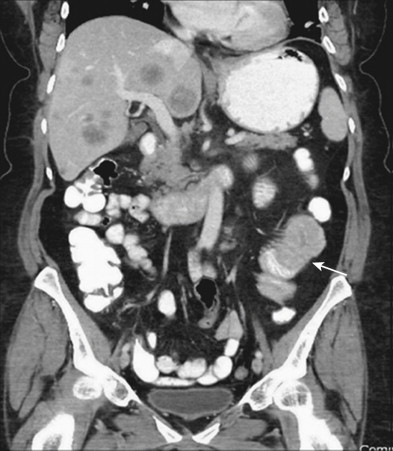
The vague clinical presentation of these tumors, usually abdominal pain and less often GI bleeding, is also contributory. These data underlie the need for a reliable method of examination when there is a possibility of SB neoplasm or unexplained abdominal symptoms and upper and lower GI evaluations are unrevealing. The role of imaging in these patients is to rule out or confirm early SB tumor reliably. SB tumors are rare and frequently underdiagnosed or diagnosed late (see Fig. 39-3 ). Curative resection remains the only curative therapy for SB malignancies. There is no rigorous imaging comparison evaluating multiple peroral SB examinations and intubation-infusion distended SB modifications. A prior comparison of orally ingested SB barium examination with enteral volume-challenged examinations showed the sensitivity of orally ingested SB examination to be 61%, whereas that of enteroclysis was 95%. This result highlights the difference in diagnosing filling defects when the SB is distended.
There have been no rigorous head to head comparisons between CTE and MRE or between CT enterography and MR enterography. MR imaging is frequently recommended because of the lack of ionizing radiation. Both CTE and MRE have been shown to have high accuracies, more than 90%, but the discomfort of intubation has been a deterrent, and hence the rationale for recommending MR enterography.
However, this deterrent is not an issue when appropriate conscious sedation is administered and may even be preferred by patients who do not want to drink the large amount of oral contrast and want to have no recall of their experience. There is an important factor for radiologists to consider—a lack of knowledge on the part of ordering physicians who want to do what is best for their patients but do not understand which imaging study is the most reliable to answer questions relevant to patient work-up and management in the evaluation of SB diseases, particularly when the possibility of SB neoplasm is concerned. Radiologists must function as consultants, so that when orally ingested SB examination results are not informative and unexplained abdominal symptoms persist, recommendation should be made to refer these patients to centers in which enteral, volume-challenged examinations are routinely performed.
An added role of CTE in the work-up of SB neoplasms is to guide the enteroscopist about which route to take in the evaluation of patients who may require biopsy or endoscopic removal of SB lesions. When multiple defects are present, the precise location of the largest lesion is readily estimated by CTE using currently available software. Although this can be done with neutral enteral CTE, the positive enteral CTE modification is simpler to use with vessel analysis software when required, although localization can be frequently estimated ( Fig. 39-4 ). Changes in the practice of radiology in the past 3 decades and knowledge of the long-term survival of patients with malignant SB tumors are reminders to referring physicians and radiologists of the important role of imaging in the evaluation of SB tumors.
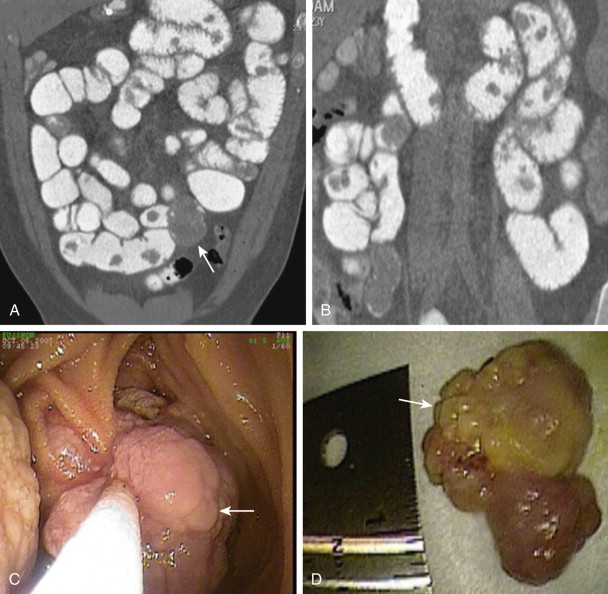
Small Bowel Obstruction
SB obstruction is a common clinical condition, often presenting with signs and symptoms similar to those seen in other acute abdominal disorders. Once suspected based on the patient’s clinical history and physical examination, radiologists must verify or exclude the presence of obstruction and provide cogent information on the site, severity, and probable cause of the obstruction and presence of strangulation. Although initial reports showed high accuracy of CT of the abdomen and pelvis with oral and IV contrasts in the diagnosis of SBO, a subsequent evidence-based comparison showed an overall accuracy of 65%. In this analysis, however, the accuracy of conventional CT increased to 81% for high-grade and complete obstruction. With low-grade obstruction, accuracy was 48%, statistically similar to the sensitivity of abdominal radiography for SBO.
These patients have recurrent symptoms, and additional conventional CT examinations are often obtained until the obstruction becomes severe enough to be diagnosed. In patients with symptoms of recurrent low-grade adhesive obstruction, following an initial negative orally ingested CT examination usually done in the emergency department, a recommendation should be made to the referring physician that if a further investigation is needed, these patients should be referred for enteral volume-challenged examinations. In this subset of patients, similar to patients with suspected SB Crohn’s disease or tumor, repeated examinations that are unable to rule out obstruction reliably are done before appropriate imaging is requested. Findings of adhesions are often present in retrospect but are not confidently diagnosed because of the lack of an appreciable transition point; the latter is exaggerated with enteral, volume-challenged examinations. This diagnosis should be made even when nonobstructive, because these are known to cause symptoms of recurrent or chronic abdominal pain in patients with prior abdominal surgery ( Figs. 39-5 and 39-6 ).
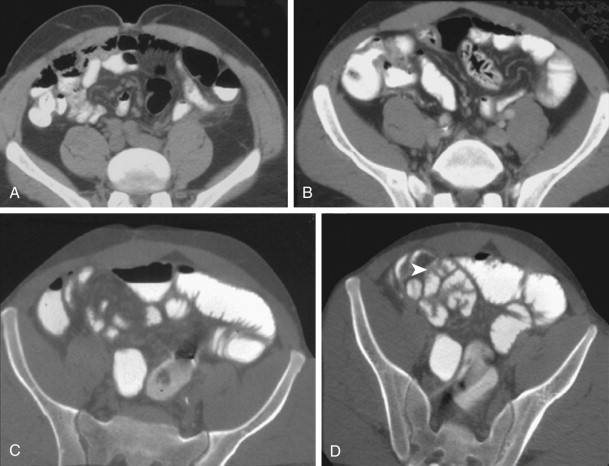
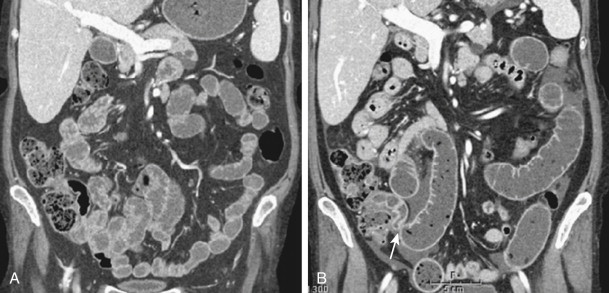
Dense, anterior, parietal peritoneal adhesions increase the risk of bowel injury during laparoscopy and may require alternative trocar insertion sites. The number and sites of SBO and length of the SB proximal to the first point of obstruction assist the surgeon in deciding whether an adequate absorptive surface is available for the formation of an ostomy or bypass (generally, 125 cm). Conventional CT and other nonenteral, volume-challenged examinations are not sensitive for lower grades of SBO that present usually in the subacute phase. CTE is the most accurate method for the further investigation of these patients and in those with SBO diagnosed by conventional CT, in whom additional, management-relevant questions are not answered. In the former group of patients, symptoms frequently subside with nonsurgical management.
Confirmation of the diagnosis by CTE prevents the repeated performance of orally ingested enteral contrast SB CT or MR examinations. These examinations neither confidently diagnose nor exclude low-grade obstruction in the appropriate clinical setting. A larger volume of neutral oral contrast may minimize this disadvantage, but patients with this condition experience nausea and sometimes vomit with the volumes given for CT enterography. Not infrequently, they are unable to finish ingesting the optimal volume required. By directly infusing contrast into the SB and providing a fluid volume challenge, the presence of an existing low-grade obstruction, gradient, or prestenotic dilation is exaggerated and reliably diagnosed; vomiting is avoided by controlling infusion rates fluoroscopically and understanding several variables involved in enteroclysis that require fluoroscopic guidance (see Fig. 39-6 ). Even when no gradient is observed, demonstration of subtle deformities such as luminal narrowing and fixations are easier to appreciate. Real-time (fluoroscopic) observations add to the confidence in making or excluding the diagnosis.
This observation adds to the morphologic details provided by multiplanar CT. Cross-referenced assessment provides more precise assessment of the location and characterization of the cause. The positive enteral CTE modification is preferred for this subset of patients, although this condition can be diagnosed also with neutral enteral CTE with IV contrast. The lack of real-time control by the radiologist on the rate of infusion and volume needed for neutral enteral CTE add to the possibility of vomiting in this group of patients, which makes this modification less ideal. The method can be modified, particularly in patients with inflammatory SB disease with low-grade obstructive symptoms, with indirect monitoring of the infusion rates; this requires fluoroscopic guidance. Determining the optimal infusion rates on either modification is difficult and requires experience because there are several variables that influence it, and each patient is different. In the subset of patients with recurrent symptoms, a subtle gradient or transient stasis may be observed fluoroscopically and may not be depicted on the CT image.
Correlating the fluoroscopic observation and the anatomic information depicted by multiplanar CT allows a confident report of low-grade adhesive obstruction from a parietal or visceral adhesion or both. Neutral enteral with IV contrast CTE excels in evaluating mural abnormalities in addition to the mesentery and solid viscera. In patients in whom the obstruction has resolved, adhesions are still reliably visualized on CTE. When patients with a history of malignant neoplasm and prior abdominal surgery present with an SBO, radiologists are often faced with the difficult task of determining the exact cause of the obstruction. CTE provides the necessary intraluminal and extraluminal information to help differentiate SBO caused by seeded or hematogenous metastases from that caused by radiation exposure or postsurgical adhesions. Thus, in addition to anatomic information regarding tumor size and location, CTE can reliably assess for the presence of associated low-grade obstruction.
There is a subset of patients with SBO for whom surgeons prefer initial conservative management (i.e., tube decompression of the distended SB) over surgery. These are patients with the following: (1) SBO in the immediate postoperative period; (2) a history of prior abdominal surgery for a malignant tumor; (3) a prior history of radiation therapy; or (4) Crohn’s disease with prior surgery. Further characterization of the severity and nature of the obstruction are of value for management. The use of the triple-lumen, long decompression-enteroclysis (Maglinte Long Tube; MDEC, Cook, Bloomington, IN) has allowed us to participate in the management of these patients by preliminary decompression of the distended SB, performance of a diagnostic CTE, and further long-tube decompression after the examination.
The use of positive enteral CTE allows assessment of the cause and severity of the obstruction in addition to more efficient, long-tube suction ( Fig. 39-7 ). Participation in the care and management of this subset of patients is important for radiologists to consider; it could help change the low prestige and perception of mediocrity of radiology as a specialty by other physicians.
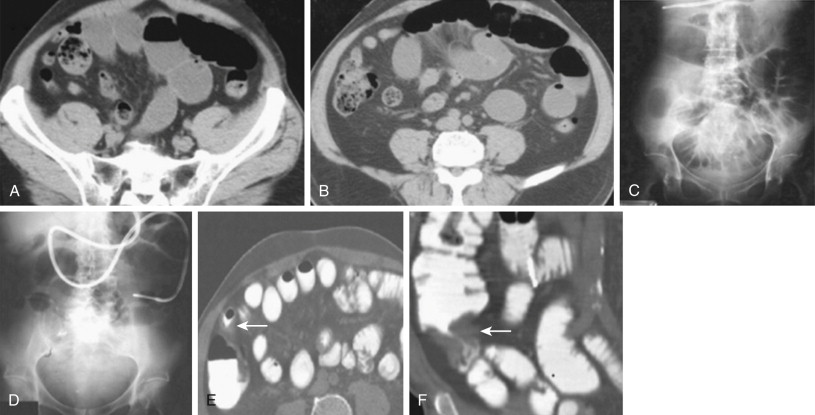
Our technique of examination is modified in patients with a prior history of pancreatoduodenectomy (Whipple procedure). They may present with symptoms in the subacute or chronic setting unexplained by cross-sectional imaging, which is now the routine examination of the postoperative pancreas, and questions relevant to management require evaluation of hepaticojejunal, pancreatojejunal, gastrojejunal, and pylorojejunal anastomoses. The catheter tip and balloon are positioned immediately distal to the gastroesophageal junction and retracted until mild resistance is met to prevent gastroesophageal reflux during controlled infusion. This modification allows for the evaluation of the pylorojejunal anastomosis and hepaticojejunal and pancreatojejunal anastomoses, as well as distal segments of the SB in real-time and cross-sectional images. This modification has been termed the CT Whipplegram for lack of a better name ( Fig. 39-8 ). It simplifies the evaluation of all the anastomoses and the distal SB when partial obstruction enters the differential diagnosis to explain postoperative symptoms in those with prior lower abdominal surgical procedures. We also use this modification in patients with prior Billroth procedures or prior partial or total removal of the upper GI tract and a Roux-en-Y anastomosis ( Fig. 39-9 ). The balloon and catheter tip are positioned immediately distal to the anastomosis. The esophageal anastomosis is evaluated initially using enteral contrast with the catheter tip above it before advancement of the catheter. This simplifies the examination of this subset of postsurgical patients, in whom examination is difficult with orally ingested contrast with conventional fluoroscopic or cross-sectional imaging. The timing of surgical intervention, as well as the optimal method of radiologic investigation in patients with incomplete, open loop SBO, has changed during the past 2 decades.
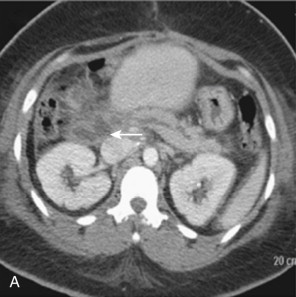
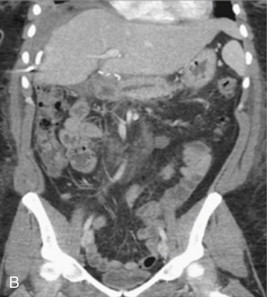
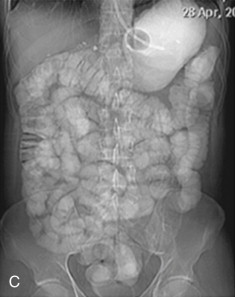
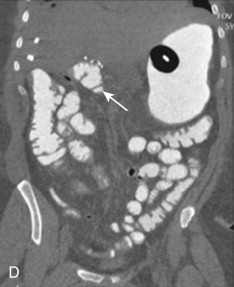
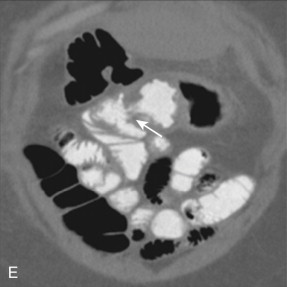
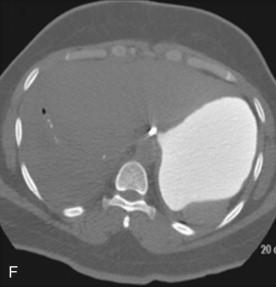
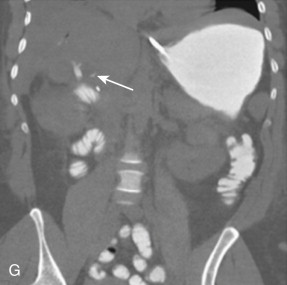
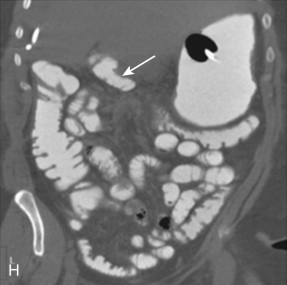
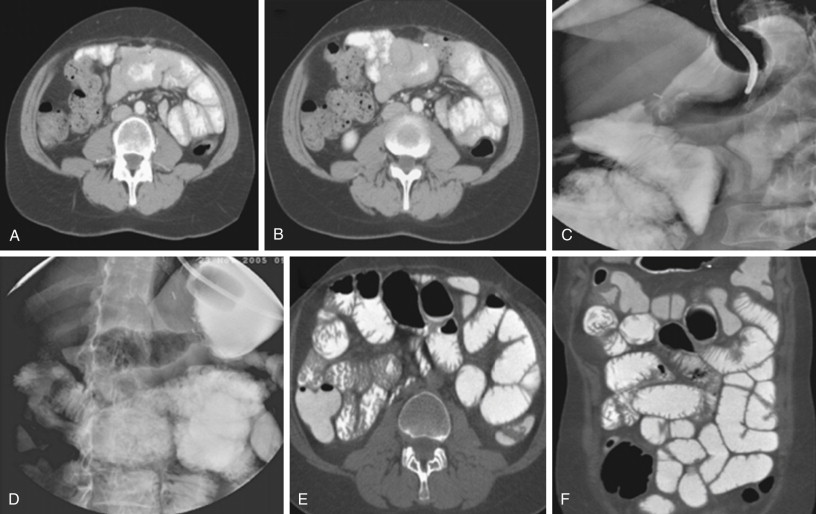

Stay updated, free articles. Join our Telegram channel

Full access? Get Clinical Tree





